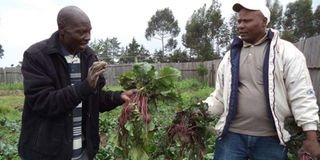Group bets on nutritional and medical qualities of beetroot

Kahuru Farmers Self Help Group members, Titus Kariuki and Anthony Kinya discuss a point at one of their beetroot plots. The group initially cultivated Irish potatoes but dwindling fortunes saw them invest in beetroots. PHOTO | WAIKWA MAINA | NATION MEDIA GROUP
What you need to know:
- Kahuru Farmers Self Help was formed five years ago. Mr Kinya says that the group initially had 28 registered members but half of them withdrew their membership due to potato market frustrations.
- Motivated by good returns and guaranteed market, the group members have gradually increased the size of land planted under beetroot from eighth of an acre to current 1.5 acre.
- According to agronomist Peter Chege, with proper agronomy, an acre of beetroot can produce more than of 5,000kg of the cylindrical roots.
- Beetroot should be on every family’s menu. But it should be sparingly used, not more than three times in a week.
The green and reddish patches beckon from miles. Unlike other parcels of land uniformly covered in green flowering potato plantations, the patches here are shorter.
At the farm, we find two men, Anthony Kinya and Titus Kariuki all smiles as they leisurely inspect the small plots placed under beetroot; a relatively new crop in Kinangop and entire Nyandarua County – an Irish potato zone.
But as Mr Kinya narrates, there was nothing to smile about when they cultivated Irish potatoes for five years.
The beetroot farm at Mutini village, a few kilometres from Engineer town, is owned by a 14-member group drawn from the informal sector.
Kahuru Farmers Self Help was formed five years ago. Mr Kinya says that the group initially had 28 registered members but half of them withdrew their membership due to potato market frustrations. “Our objective was to engage in potato farming to earn extra income,” he says.
But things did not work out. We made no profits in five years we planted potatoes,” says Mr Kinya, the group’s vice secretary.
He says potatoes will always flood the market and brokers take advantage of this to exploit farmers.
Then last year, the remaining members decided to try beetroot farming. After conducting a market research, they planted the crop on eighth acre piece of land for trial.
“The crop failed due to prolonged drought. We, however, realised that the crop can do well in this area and we did more trials between last December and March when we decided to fully venture into beetroot farming,” says Mr Kariuki, the farm manager .
Motivated by good returns and guaranteed market, the group members have gradually increased the size of land planted under beetroot from eighth of an acre to current 1.5 acre.
The other important lesson they have learned is that the crop is better planted in seedbed then transplanted two weeks after.
From quarter acre farm they planted in March, the members harvested 750kg earning Sh75, 000 after selling a kilo at Sh100.
ADD NITROGEN TO THE SOIL
From a similar piece of land, they earned Sh20,000 from twenty bags of potatoes harvested selling each bag at Sh1,000.
“The cost of production for potatoes was very high at almost Sh7, 000 compared to that of beetroot – Sh5, 000 inclusive of labour. We did not apply any chemicals or fertilisers compared to potatoes where we used 20kg of fertiliser when planting and sprayed four times for pest and disease control,” says Mr Kariuki.
According to agronomist Peter Chege, with proper agronomy, an acre of beetroot can produce more than of 5,000kg of the cylindrical roots.
With lessons gained over the last few months, the group is optimistic of harvesting an average of 6,000kg of beetroot from the one and half acre land.
The group has set up a number of seedbeds to increase the total acreage to four by next month.
Mr Kariuki says the seedlings are ready for transplanting a week after germination.
“It’s advisable to grow potatoes prior to planting the beetroot, this helps to loosen the soils. For maximum land utility, we are intercropping with snow peas which also help add nitrogen to the soils. This way we do not have to add any nitrogen fertilisers,” says Mr Kariuki.
In other sections of the farm, the group is inter-cropping beetroot with cabbages which are doing equally well.
But Mr Chege says inter-cropping with cabbages may be counter productive in future since cabbages are heavy feeders.
The group’s ultimate objective is to grow enough to supply established markets and do value addition. To make the dream come true, the group requires a capital injection of more than Sh4.5 million to invest in an irrigation system and a processing plant.
Dr Mwangi Njururi, a nutritionist classifies beetroot as among most nutritious and medically rich crops.
“Beetroot should be on every family’s menu. But it should be sparingly used, not more than three times in a week.” he says.




